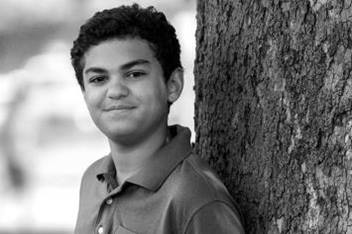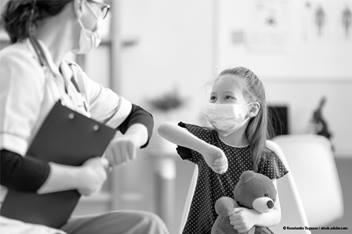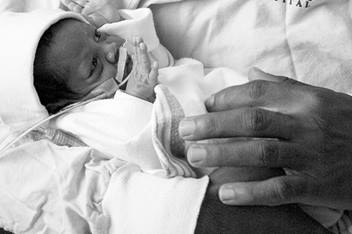Persistent Pulmonary Hypertension of the Newborn (PPHN)
![]()
Persistent pulmonary hypertension of the newborn (PPHN) is a dangerous condition that may cause a baby to not get enough oxygen after birth.
During pregnancy, babies get all of the oxygen they from the mother through the placenta. The placenta is an organ in the mother's womb that is connected to the umbilical cord. This pathway lets oxygen and nutrients go from the mother's blood to the baby.
Until the baby is born, the blood vessels going to the baby's lungs (pulmonary vessels) are closed. The blood bypasses the lungs and flows to the rest of their body.
At birth, when the baby takes their first breath, the pulmonary vessels should open. The blood should be able to flow through the baby's lungs and pick up oxygen from the air they breathe.
With PPHN, the blood vessels to the baby’s lungs do not open fully. Closed blood vessels cause:
- Too much blood to bypass the lungs. The brain and the body may not get enough oxygen.
- Too much pressure to build up in the blood vessels to the lungs. High blood pressure (pulmonary hypertension) can hurt the baby's heart and lungs.
Risk Factors
The cause of PPHN is not known. Babies are at greater risk if they have:
- Breathed in their own bowel movements before birth (meconium aspiration)
- Lack of oxygen before or during birth
- Infection in their lungs or blood
- Abnormal development of the heart or lungs
- Been born to a mother with diabetes mellitus
- Been born large for gestational age (LGA). Gestational age is the age of the baby in the womb. LGA babies are larger than more than 90% of all other babies born at the same gestational age.
Signs and Symptoms
Neonatology
Looking for services or physicians who can help treat this condition?
At birth, or within the first hours after birth, the baby will have:
- Fast breathing and a fast heart rate
- Grunting or moaning when breathing
- Retractions - the skin between and under the ribs pulls in during fast and hard breathing
- Blue color of the lips and around the mouth, called cyanosis
- Low amount of oxygen carried in the blood (oxygen saturation) even after getting oxygen
- Lower oxygen saturation in the baby's legs than in the right wrist
- Low blood pressure
Diagnosis
The following tests may be done to diagnose PPHN:
- Echocardiogram (echo): This painless test uses sound waves to take a picture of the heart and blood vessels. It will show how the blood flows through the body.
- X-rays: A camera takes a picture of the lungs and can also see if the heart is too large.
- Blood tests: These tests will show changes in the number of blood cells and the level of other things like salt, sugar, and acids in the blood. They help to tell how well your baby uses oxygen or if they have an infection.
- Pulse oximeter: This checks oxygen saturation levels.
Treatment
The goal of treatment is to increase oxygen levels in the blood, open the blood vessels in the lungs, and maintain a normal blood pressure. This is done with oxygen, medicines, and fluids.
- Your baby may get oxygen by:
- Nasal cannula: A small tube with prongs is placed in the nostrils and hooked up to oxygen.
- Continuous Positive Air Pressure (CPAP): This machine gently pushes air or oxygen into the lungs.
- Ventilator: This machine will breathe for your baby until the baby can breathe on their own. The physician will put a breathing tube down their windpipe. This is called intubation (in-too-BAY-shun). The breathing tube is then hooked up to the ventilator. The ventilator is programmed to give your baby even and regular breaths.
- High frequency oscillation ventilation: This is a special type of ventilator. It can deliver rapid, short bursts of air through a breathing tube.
- Medicines and fluids are given by intravenous catheter (IV). A small, flexible tube is put into 1 or 2 of the blood vessels. It is also used to get blood samples. The IV tube is placed in either:
- The umbilical cord, called an umbilical IV
- An arm or leg, called a peripherally inserted central catheter (PICC line). The PICC line goes from the arm or leg and ends in a large blood vessel near the heart.
- The types of medicines given are:
- Blood pressure medicine: to keep the blood pressure at the right level
- Antibiotics: to treat or prevent infection
- Sedatives: to help your baby rest and stay calm. When the baby is calm, the machines that give him oxygen can work better and he may need to use less.
- Surfactant: to help the lungs work better. Surfactant allows the lungs to use oxygen and get rid of carbon dioxide. It is given to the baby through a breathing tube.
Warning
- The medical device tubing can get wrapped around a child's neck. This can lead to choking (strangulation) or death.
- DO NOT leave the medical device tubing where infants or children can get tangled up in it.
- Talk to your child's health care provider:
- If your child has been tangled in their tubing before.
- To learn steps you can take to help make sure the tubing does not get wrapped around your child's neck, such as keeping the tubing away from the child as much as possible.
- Any other concerns you may have about the risk of strangulation from medical device tubing.
- If your child is injured by medical device tubing, please report the event to the FDA. Your report can provide information that helps improve patient safety. The website to make a report is: https://www.accessdata.fda.gov/scripts/medwatch/index.cfm?action=reporting.home
Severe and Life-threatening PPHN
If other treatments don't work, very severe PPHN may be treated with:
- Nitric oxide - This is a gas that helps expand the blood vessels in the lungs.
- Extracorporeal membrane oxygenation (ECMO) - Your baby’s blood is pumped through a machine that acts as a lung. It puts oxygen right into the blood. It also takes out carbon dioxide before pumping the blood back into the baby. If your baby needs ECMO, their health care provider will explain it to you.
HH-I-270 1/07 Revised 4/22 Copyright 2007, Nationwide Children’s Hospital



